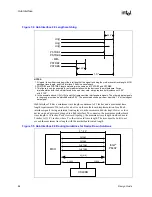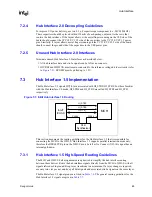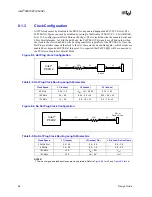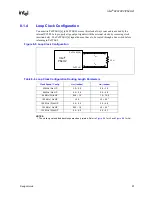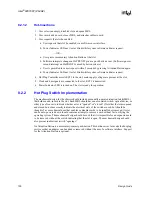
Design Guide
85
Hub Interface
The Hub Interface signals must be routed directly from the MCH to P64H2 with all signals
referenced to ground. Maintain a consistent ground reference plane at all times. In addition, route
all signals within a data group (consisting of nine bits of data and a pair of strobes) on the same
layer and reference them to the same ground plane. Keep layer transitions to a minimum. If a layer
change is required, use only two vias per net and keep all signals within a data group on the same
layer.
Route the Hub Interface 2.0 data signal traces 5 mils wide using the recommended stackup. There
must be 15 mils spacing between signal traces (5/15). Each strobe signal must have a minimum of
35 mils of spacing from any adjacent signals to minimize effects that cause signal degradation. To
break out of the MCH and P64H2 package, the hub interface data signals can be routed 5/5. The
signals must separate to 5/15 (or strobes to 5/35) within 0.5 inch of the package.
Hub Interface 2.0 requires package length compensation, which is similar to the system bus
package length compensation. For E7500 chipset component package lengths, refer to the
component datasheets.
For Hub Interface 2.0 devices on the motherboard, package trace length matching of ± 0.25 inch
(including package length compensation) is required among all signals within a data group. If the
hub device is on an adapter, length matching of ± 0.125 inch (including package length
compensation) is required among all signals within a data group. The hub interface strobe trace
lengths must be 0 to 1.0 inch shorter than the longest hub interface data trace.
depicts the length matching rules for a hub device on the motherboard. All of the Hub
Interface Data signals must be length matched within 0.25 inch. The figure shows HI[x] and HI[y]
with the maximum allowed difference in length, while HI[z] is somewhere in the middle. The
strobes in each strobe pair (PSTRBF and PSTRBS; PUSTRBF and PUSTRBS) are also matched
within 0.25 inch. However, the absolute length of the strobe pair is adjusted according to the
longest Hub Interface Data line
.
The upper pair shows the case where one of the strobes is the
same
exact
length as the longest Hub Interface Data line (which is the longest possible length one
of the strobes can be). In this case, the other strobe
must
be equal to or shorter than it, but by no
more than 0.25 inch. The lower strobe pair shows the case where one of the strobes is
exactly
1.0 inch shorter than the longest Hub Interface Data line (which is the shortest possible length one
of the strobes can be). In this case, the other strobe
must
be equal to or longer than it, but by no
more than 0.25 inch.
Summary of Contents for Xeon
Page 24: ...Introduction 24 Design Guide This page is intentionally left blank ...
Page 30: ...Component Quadrant Layout 30 Design Guide This page is intentionally left blank ...
Page 52: ...Platform Clock Routing Guidelines 52 Design Guide This page is intentionally left blank ...
Page 66: ...System Bus Routing Guidelines 66 Design Guide This page is intentionally left blank ...
Page 118: ...Intel 82870P2 P64H2 118 Design Guide This page is intentionally left blank ...
Page 146: ...I O Controller Hub 146 Design Guide This page is intentionally left blank ...
Page 148: ...Debug Port 148 Design Guide This page is intentionally left blank ...
Page 210: ...Schematic Checklist 210 Design Guide This page is intentionally left blank ...
Page 220: ...Layout Checklist 220 Design Guide This page is intentionally left blank ...
Page 222: ...Schematics 222 Design Guide This page is intentionally left blank ...
















